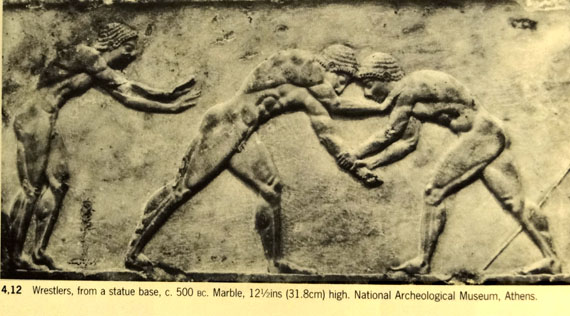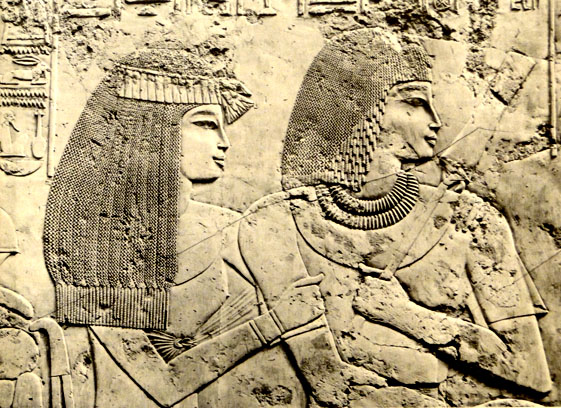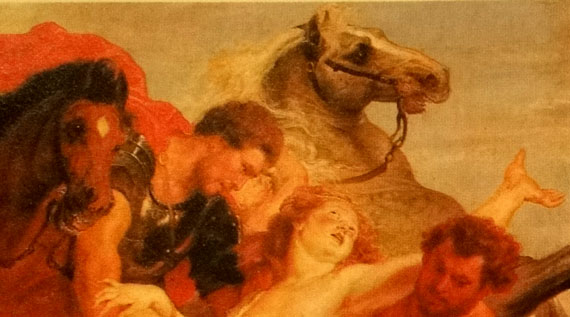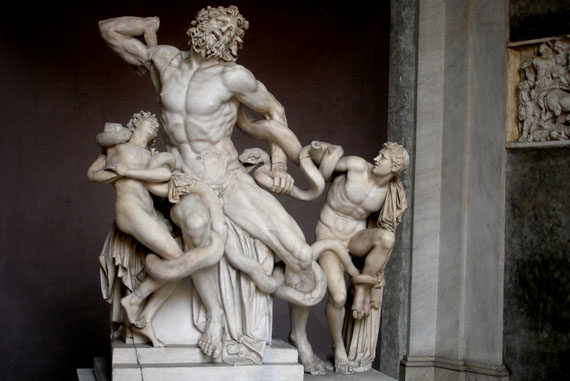
[HOME ] [ABOUT] [PHOTOS] [VIDEO] [BLOG] [HOUSTON] [TEXAS] [U.S. NEWS] [WORLD NEWS] [SPORTS] [POP CULTURE] [CONTACT]
Part II Homosexuality unveiled: Is it an unAfrican practice?

Map of Greece and the City of Troy
by Joseph Earnest January 6, 2014
Newscast Media HOUSTON, Texas—There is a debate that has been occurring for years between liberals and African nations about whether the practice of homosexuality is unAfrican. This next segment will take a detailed look at this practice and its origins.
The origin of same-gender intercourse can be traced as far back as classical antiquity in which the Greeks celebrated the male nude or Kouros. The primary role of women at the time was to reproduce in order to extend the bloodlines. Greek art and sculpture often depicts graphic relations between males, particularly older males with young boys. Even their athletics like wrestling, were practiced in the nude as shown below:

However, despite claims that Africans also used to engage in this practice, that is considered unnatural around the continent—not a single advocate for the homosexual lifestyle has been able to provide evidence of artwork in any African culture, ancient or modern, that celebrates this lifestyle.
Most Greek philosophers were trained in Egypt, including Pythagoras, and the Greeks actually derived their alphabet from the Egyptians. What the Greeks found unique about Egypt, was that they celebrated their women and carved statues of them. Women in Egypt were also allowed to hold high offices and even ruled Egypt or Kemet as it was known. Make no mistake, ancient Egypt was 100% Black but was later on lightened, after the invasion of the Turks who drove the native Egyptians south. It is the reason why most Egyptian statues are smashed on the noses and lips, to conceal the African features. Today the remnants of the indigenous Egyptians can be found in places like Aswan and Luxor Egypt.
The rest of Northern Africa at the time was occupied by Berbers, Moors and Tuaregs, in fact the Tuaregs can be found in Mali, Niger and some parts of Algeria.
When the Greeks visited the Egyptians who were the fathers of modern medicine, they saw carvings like the one below:

The carving above is of a pharaoh and his wife. Such male-female statues were very rare in ancient Greece because men showed affection to other men, while women were considered domestic objects whose purpose was to procreate. In Egypt, one can clearly see the affection between opposite sexes.
Greek women were also excluded from the arts like music and painting and in nearly all cases denied an education despite possessing gifts and talents in the performing and visual arts.

The vase above depicts an aristocratic Greek woman teaching music to a younger female student who is seated, while another female who possibly is a maid, is behind holding yet another instrument. Greek women used such depictions on pottery to display their talent because they had been excluded from the arts and literature.
It wasn't until the Hellenistic period, which was the height of Greek civilization, that women started capturing the spotlight. In addition, the Trojan war that was precipitated after the abduction of Helen, enhanced the status of women. The whole story was captured by one of the most famous Greek poets named Homer, the author of Iliad and the Odyssey. While the Greeks did not have a Bible, these two volumes of work would serve as the two testaments for the Greeks. In both books the heroes seek glory and the kings and gods pursue justice. Zeus, for example, punishes those who do evil such as breaking their oaths, rendering false judgments or violating the rules of hospitality.
Which brings us to The Trojan War and its genesis. In Homer's Iliad, a Trojan prince named Paris, visits the Greek king Menelaus, and while a guest at the king's house, Paris abducts and flees with the king's wife, the beautiful Helen. Because of Paris' crime, the gods destroy Troy. For the first time in classical antiquity, we see that an entire nation goes to war, to redeem the honor of one woman. After ten years of fighting, Troy was sacked and Helen was returned to Melenaus her husband.
The Romans too were known to practice homosexuality especially in times of war, but that behavior also had a spill-over effect into their daily and social lives. In ancient Rome they too celebrated the male nude figure, one of the most popular being the god Apollo. Yet later on, Romans, like Greeks who had conquered Egypt, learned to celebrate femininity in their artwork and literature. Some readers are familiar with the mythological tale of the founding of Rome, whereby two twins named Romulus and Remus were rescued and nursed by a she-wolf. Romulus would then found Rome after killing his brother Remus, naming the new city, Roma after himself. This of course is fiction and one of the many Roman legends.
However, there is another Roman legend about the founding of Rome that gravitates around defending a woman's honor, very much like the Trojan war.
According to the historian Livy (59 B.C.-17 A.D.) the early Romans, who were actually referred to as Etruscans, were defeated in a battle after the rape Lucretia by Sextus the son of Etruscan king Tarquinius Superbus (534-509 B.C.). Lucretia was the wife of an aristocrat named Tarquinius Collatinus. Livy claims what attracted Sextus to Lucretia was her modesty. While other women were out having a merry time during the absence of their husbands, Lucretia stayed home spinning wool.
During the absence of Collatinus, the cunning Sextus entered his friend's house as a guest and forced himself upon his wife Lucretia. When Lucretia refused, Sextus threatened to cut her head off, and said he would claim he caught her in bed with one of the male servants. Lucretia stopped fighting and Sextus had his way with her. Ashamed, in spite of her innocence, Lucretia told her husband what had been done to her, and also told her husband's relative Lucius Junius Brutus about the violation.
Unable to bear the shame, Lucretia fell on her own dagger rather than live in dishonor. Her very last words were: "In your bed, Collanitus, is the impress of another man. My body only has been violated. My heart is innocent...Give me your solemn promise that he shall be punished--his name is Sextus Tarquinius. He, it was, who last night came as an enemy disguised as my guest, and took pleasure of me. What due him, is for you to decide. As for me, I am innocent of fault, but will take my punishment."
(Livy, The Early History of Rome, pp. 98-99).
To avenge her honor, Collatinus and Brutus raided and drove out all the Etruscan kings and established the Republic. Lucretia's story reveals a premium placed by Roman nobles on defending family honor and avenging it when necessary.
The story is also a celebration of the feminine glory that was demonstrated by the Egyptians, copied by the Greeks and later adopted by the Romans.
The Greeks and Romans continued to practice homosexuality, but they also showed a raw passion for women, unlike the era before the Hellenistic period. Yet even up until the High Renaissance, women were depicted in both paintings and sculpture engaged in violent sex scenes. Some of the most celebrated paintings and statues in Europe are those of women being raped like the Rape of Proserpina by Berinini, the Rape of Sabine's daughters by Giovanni Bologna, Bernini's Daphne and Apollo (in which Apollo is pursuing Daphne to rape her, then she turns into a laurel tree) and the Rape of the daughters of Leucippus by Flemish painter Rubens as shown below:

Painting by Peter Paul Rubens of the Rape of the daughters of Leucippus. The painting has been cropped out for obvious reasons, but is one the most celebrated paintings around the world. Rubens is known for painting his subjects as full-figured women, from where we derive the term "Rubenesque" to refer to a big woman.
While the Africans exalted their women in art and real life, the Europeans portrayed theirs as sex objects, and men were celebrated as perfect human specimens as shown in this ancient Greek statue of Laocoon and his two sons:

Laocoon and his two sons (200-70 B.C.) The legend of this Greek sculpture is that while Laocoon and his two sons were making an offering, a serpent came out of the sea and consumed them. The group shows adult and young nude males in perfect physical condition, with athletic bodies celebrated by the Greeks.
—Photo by Joseph Earnest, the Vatican Museums, Vatican City.
During the renaissance and counter-reformation, sacred art began to emerge in European paintings that portrayed women modestly, for example the Madonna and Child, the Annunciation, the Assumption of the Virgin and many other female saints and also virtues that were placed on public display. The secular art, however, did the opposite, particularly art produced by the French impressionists.
Now that we have laid the background of the origin of homosexuality, let's take a look at how it is attempting to manifest itself in the African culture in Part III>>
Related stories:
Part I Unveiled: Common misconceptions-Facts, Fiction and Fallacies
Part II Unveiled: Is homosexuality an unAfrican Western behavior?>>
Part III Unveiled: Africa pushes back against the hedonism of our day
Part IV Unveiled: The cultural conflict between the West and Africa>>
|
|
Join the Newscast Media social networks
for current events and multimedia content.
Copyright© Newscast Media. All Rights Reserved. Terms and Privacy Policy
